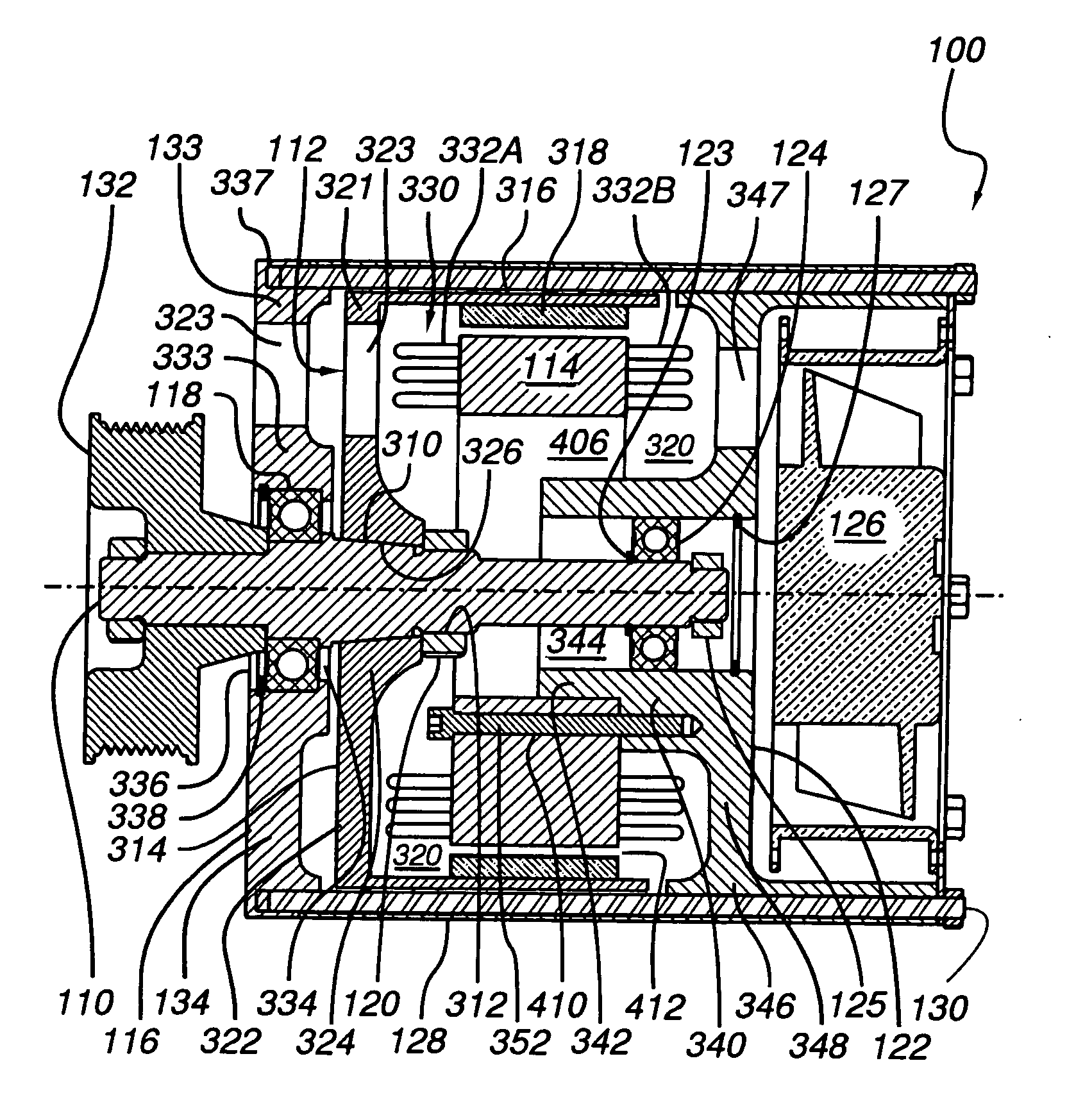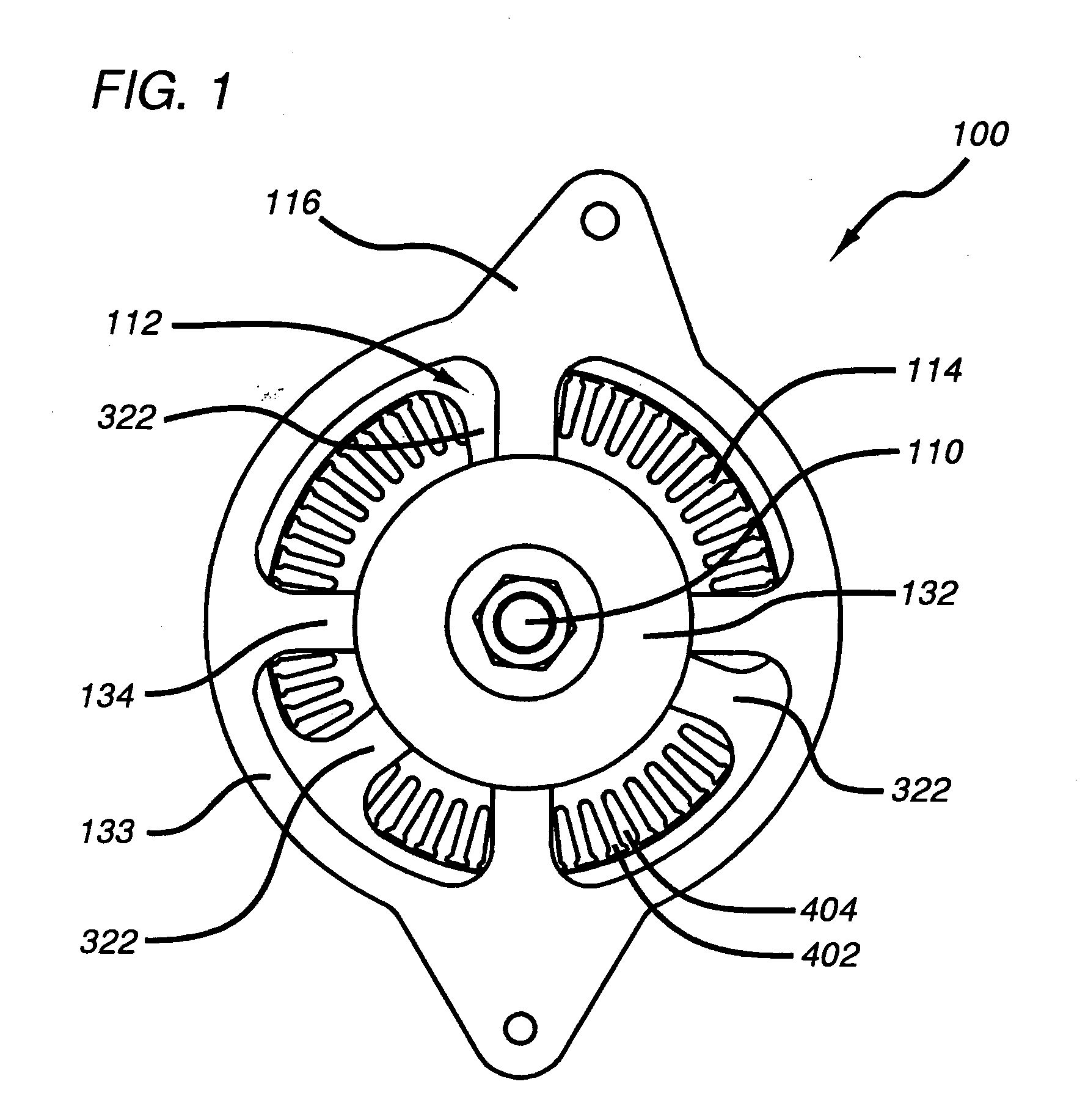Compact high power alternator
a high-power, compact technology, applied in the field of machines, can solve the problems of impracticality of voltage regulation and control of individual windings, difficulty in using high-output alternators, and disadvantages of claw-type generators, and achieve the effect of facilitating cooling and increasing the surface area of windings
- Summary
- Abstract
- Description
- Claims
- Application Information
AI Technical Summary
Benefits of technology
Problems solved by technology
Method used
Image
Examples
embodiment 329
[0089] However, it is advantageous, in applications employing control systems dependant on synchronization with the output, to have a power output wave with a particular waveform, e.g., sloping sides, to enhance control timing. This can be accomplished by establishing progressive (gradual) interaction between the rotor magnets and core teeth. Such progressive interaction can be provided by, for example, by utilizing teeth and slots with an edge skewed with respect to magnets 318, e.g., manifesting a generally helical shape. In a laminar core such teeth and slots can be formed using a slight and progressive radial skewing of each successive lamination so that the net effect after welding or epoxying is a lamination stack with a predetermined offset in the radial position of a given tooth from the front face of the lamination stack to the rear face. In the preferred embodiment, the offset is the equivalent of one tooth (e.g., the “nth” tooth on the front face is aligned with tooth “n+...
first embodiment
[0147] Referring to FIG. 12, a sealed alternator 1200 comprises: shaft 110; a sealed front end plate 1202; front bearings 118; stator 114; a forward facing rotor 1204; jam nut 120; an internal fan 1206; rear bearing 124; a sealed rear endplate 1208; a heat exchanger 1210; an external fan 1212 and a fan housing 1213 with an air intake 1214. (In this embodiment, tie rods 130 (not shown) may be disposed externally, as illustrated in FIG. 4) Front end plate 1202 suitably includes a stepped central hub 1214 (generally analogous to rear endplate hub 340 in the embodiment of FIG. 3) for mounting and locating front bearing 118, and stator core 328. Tapered portion 310 of shaft 110 is disposed at a predetermined axial distance from front end plate 1202 (generally corresponding to the axial length of rotor 1204). Rotor 1204 is essentially the same as rotor 112, but with the tapered portion of hub 324 reversed to accommodate a forward facing disposition of rotor 112. As in the embodiment of FI...
embodiment 1400
[0153] In some instances, it may be desirable to employ pressurized external air from a source located remotely from sealed alternator unit. Such an embodiment 1400 is shown in FIG. 14. Sealed alternator 1400 is substantially similar to alternator 1200 except that instead of being driven by a dedicated external fan 1212, alternator 1400 employs a rear housing 1402, the interior of which communicates with heat exchanger exterior channels 1228, cooperating with a plenum 1404 and a suitable remote pressurized air source, such as a remote fan 1406. External air flow 1234 is supplied by remote fan 1406, directed through a plenum 1404, through the interior of housing 1402 and channels 1228, and ultimately exiting through outlet 1224.
[0154] An alternative embodiment of the present invention particularly adapted for use in sandy, wet, or otherwise harsh conditions, employs a locally sealed alternator cooperating with a double walled snorkel to provide a cooling air from remote, less harsh s...
PUM
 Login to View More
Login to View More Abstract
Description
Claims
Application Information
 Login to View More
Login to View More - R&D
- Intellectual Property
- Life Sciences
- Materials
- Tech Scout
- Unparalleled Data Quality
- Higher Quality Content
- 60% Fewer Hallucinations
Browse by: Latest US Patents, China's latest patents, Technical Efficacy Thesaurus, Application Domain, Technology Topic, Popular Technical Reports.
© 2025 PatSnap. All rights reserved.Legal|Privacy policy|Modern Slavery Act Transparency Statement|Sitemap|About US| Contact US: help@patsnap.com



